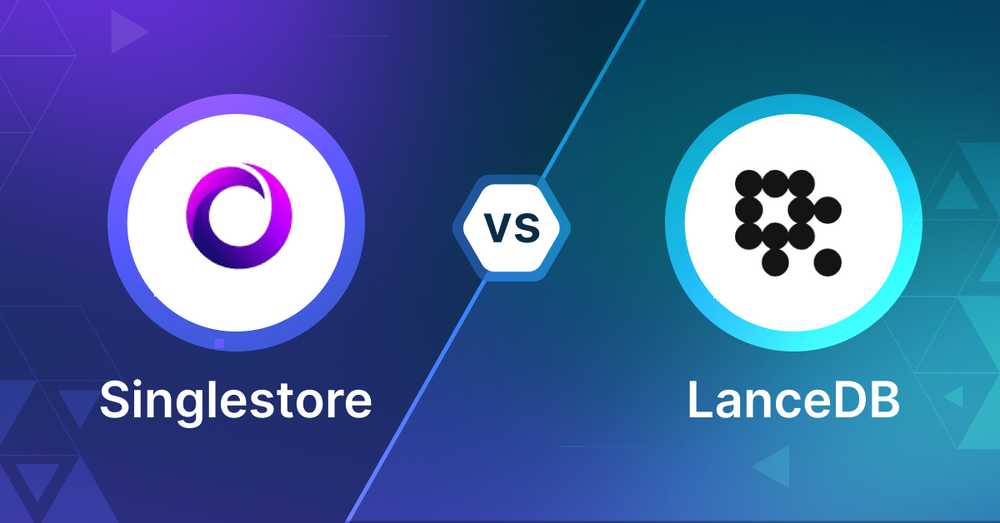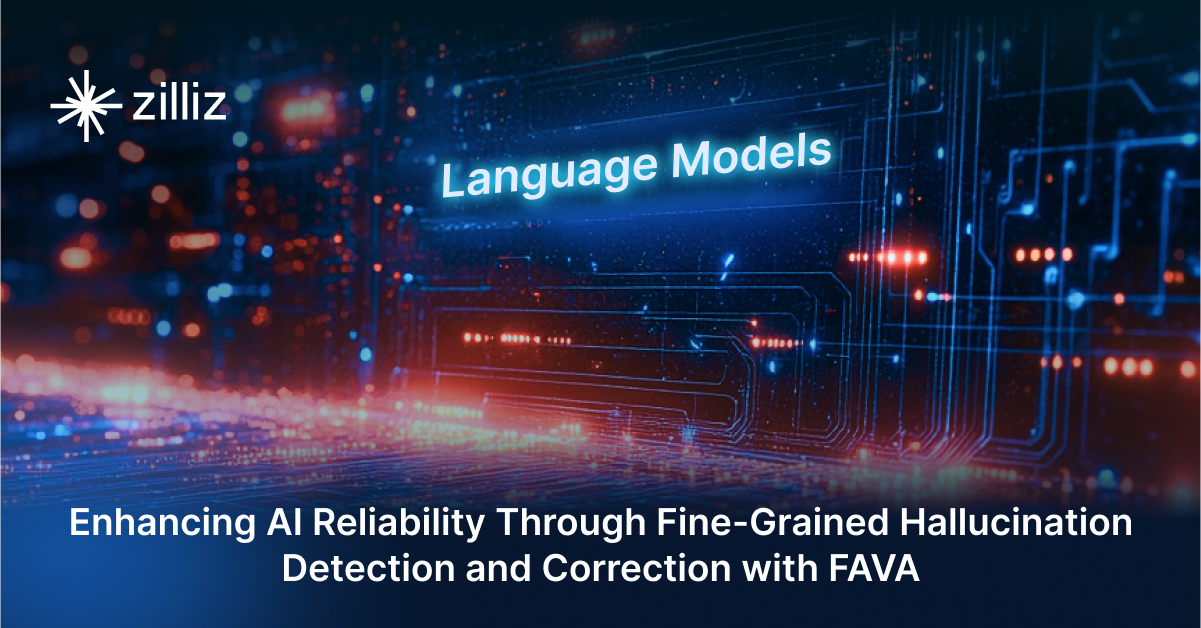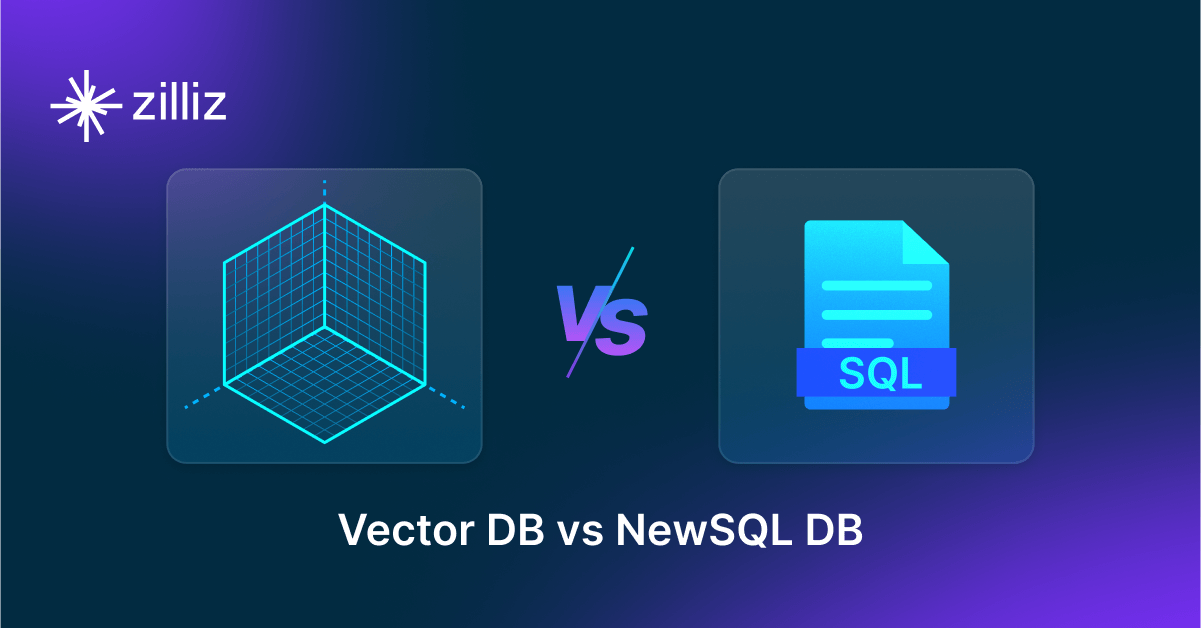SingleStore vs LanceDB Choosing the Right Vector Database for Your AI Apps

What is a Vector Database?
Before we compare SingleStore and LanceDB, let's first explore the concept of vector databases.
A vector database is specifically designed to store and query high-dimensional vectors, which are numerical representations of unstructured data. These vectors encode complex information, such as the semantic meaning of text, the visual features of images, or product attributes. By enabling efficient similarity searches, vector databases play a pivotal role in AI applications, allowing for more advanced data analysis and retrieval.
Common use cases for vector databases include e-commerce product recommendations, content discovery platforms, anomaly detection in cybersecurity, medical image analysis, and natural language processing (NLP) tasks. They also play a crucial role in Retrieval Augmented Generation (RAG), a technique that enhances the performance of large language models (LLMs) by providing external knowledge to reduce issues like AI hallucinations.
There are many types of vector databases available in the market, including:
- Purpose-built vector databases such as Milvus, Zilliz Cloud (fully managed Milvus)
- Vector search libraries such as Faiss and Annoy.
- Lightweight vector databases such as Chroma and Milvus Lite.
- Traditional databases with vector search add-ons capable of performing small-scale vector searches.
SingleStore is a distributed, relational, SQL database management system with vector search as an add-on and LanceDB is a serverless vector database. This post compares their vector search capabilities.
SingleStore: Overview and Core Technology
SingleStore has made vector search possible by putting it in the database itself, so you don’t need separate vector databases in your tech stack. Vectors can be stored in regular database tables and searched with standard SQL queries. For example, you can search similar product images while filtering by price range or explore document embeddings while limiting results to specific departments. The system supports both semantic search using FLAT, IVF_FLAT, IVF_PQ, IVF_PQFS, HNSW_FLAT, and HNSW_PQ for vector index and dot product and Euclidean distance for similarity matching. This is super useful for applications like recommendation systems, image recognition and AI chatbots where similarity matching is fast.
At its core SingleStore is built for performance and scale. The database distributes the data across multiple nodes so you can handle large scale vector data operations. As your data grows you can just add more nodes and you’re good to go. The query processor can combine vector search with SQL operations so you don’t need to make multiple separate queries. Unlike vector only databases SingleStore gives you these capabilities as part of a full database so you can build AI features without managing multiple systems or dealing with complex data transfers.
For vector indexing SingleStore has two options. The first is exact k-nearest neighbors (kNN) search which finds the exact set of k nearest neighbors for a query vector. But for very large datasets or high concurrency SingleStore also supports Approximate Nearest Neighbor (ANN) search using vector indexing. ANN search can find k near neighbors much faster than exact kNN search sometimes by orders of magnitude. There’s a trade off between speed and accuracy - ANN is faster but may not return the exact set of k nearest neighbors. For applications with billions of vectors that need interactive response times and don’t need absolute precision ANN search is the way to go.
The technical implementation of vector indices in SingleStore has specific requirements. These indices can only be created on columnstore tables and must be created on a single column that stores the vector data. The system currently supports Vector Type(dimensions[, F32]) format, F32 is the only supported element type. This structured approach makes SingleStore great for applications like semantic search using vectors from large language models, retrieval-augmented generation (RAG) for focused text generation and image matching based on vector embeddings. By combining these with traditional database features SingleStore allows developers to build complex AI applications using SQL syntax while maintaining performance and scale.
What is LanceDB? An Overview
LanceDB is an open-source vector database for AI that stores, manages, queries and retrieves embeddings from large-scale multi-modal data. Built on Lance, an open-source columnar data format, LanceDB has easy integration, scalability and cost effectiveness. It can run embedded in existing backends, directly in client applications or as a remote serverless database so it’s versatile for many use cases.
Vector search is at the heart of LanceDB. It supports both exhaustive k-nearest neighbors (kNN) search and approximate nearest neighbor (ANN) search using an IVF_PQ index. This index divides the dataset into partitions and applies product quantization for efficient vector compression. LanceDB also has full-text search and scalar indices to boost search performance across different data types.
LanceDB supports various distance metrics for vector similarity, including Euclidean distance, cosine similarity and dot product. The database allows hybrid search combining semantic and keyword-based approaches and filtering on metadata fields. This enables developers to build complex search and recommendation systems.
The primary audience for LanceDB are developers and engineers working on AI applications, recommendation systems or search engines. Its Rust-based core and support for multiple programming languages makes it accessible to a wide range of technical users. LanceDB’s focus on ease of use, scalability and performance makes it a great tool for those dealing with large scale vector data and looking for efficient similarity search solutions.
Key Differences
Search Methodology
SingleStore has a full range of vector search options including exact k-nearest neighbors (kNN) search and Approximate Nearest Neighbor (ANN) search. We support multiple index types like FLAT, IVF_FLAT, IVF_PQ, IVF_PQFS, HNSW_FLAT, and HNSW_PQ so you can fine tune the balance between search accuracy and performance based on your use case.
LanceDB takes a more focused approach to vector search with exact k-nearest neighbors (kNN) search and Approximate Nearest Neighbor (ANN) search through our IVF_PQ index. They combine vector search with full-text search and scalar indices so you can build complex search solutions. Both systems support standard distance metrics like Euclidean distance, cosine similarity and dot product, so you can use them for any similarity search.
Data Handling
SingleStore embeds vector search directly into its SQL database so you need to create vector indices on columnstore tables. We support Vector Type(dimensions[, F32]) format so you can combine vector operations with standard SQL queries. This means you can filter and aggregate alongside vector similarity search all in the same query.
LanceDB handles data through its Lance columnar format foundation designed for multi-modal data. They are good at handling different data types and support hybrid search approaches that combine semantic and keyword based methods. This makes them particularly good for applications that require flexible data modeling and complex search patterns across different types of data.
Scalability and Performance
SingleStore scales through a distributed architecture that spreads data across multiple nodes. You can scale horizontally by just adding more nodes as your data grows. Performance is optimized through an integrated query processor that can combine vector search with standard SQL queries and reduce the overhead of separate processing steps. We offer a configurable trade-off between speed and accuracy through our ANN search.
LanceDB scales through its flexible deployment options and efficient vector compression. They use IVF_PQ indexing to manage large scale vector operations. You can run LanceDB embedded in your existing system or as a serverless database, so you can scale based on your use case and load pattern. The performance can be tuned based on your deployment and application requirements.
Integration and Ecosystem
SingleStore has vector search as part of its full SQL database so you don’t need to have a separate vector database in your tech stack. The SQL interface is also very accessible to teams already familiar with traditional databases. This means you can build AI features and vector search without managing multiple systems or dealing with data transfers.
LanceDB has integration flexibility through its open-source architecture and multiple deployment options. You can embed it in your backends, run it in your client applications or deploy it as a remote serverless database. The Rust core gives you performance benefits and support for multiple languages makes it accessible to different development teams. The open-source nature of the project means community contributions and extensions are encouraged.
Ease of Use
SingleStore uses SQL syntax for vector operations so it’s very accessible to developers with database experience. The learning curve is mainly about understanding vector index requirements and optimization strategies. Since it’s integrated you can work with vectors using the same tools and approaches you use for traditional database operations.
LanceDB prioritizes developer experience through simple integration and full language support. They reduce implementation barriers while keeping the flexibility needed for complex vector search applications. The open-source community provides more resources and support for developers to learn how to use the system.
Cost
SingleStore’s cost is based on being a full database system so the cost is tied to node based scaling and infrastructure management. The initial investment might be higher than dedicated vector databases but you can save costs by consolidating multiple databases into one. The total cost of ownership should consider both direct licensing cost and the operational benefits of having vector search integrated.
LanceDB has cost advantages as an open-source so it’s good for smaller deployments or projects with budget constraints. The serverless deployment option gives you flexibility in managing infrastructure costs and self-hosted deployments gives you more control over your spend. The actual cost will vary based on your deployment and scaling requirements.
When to Choose SingleStore
Choose SingleStore when you need vector search inside a mature SQL database, have existing SQL expertise, need high concurrency support or want to combine complex SQL ops with vector search. It’s great for enterprise environments where data consolidation and SQL integration are key and you need a range of vector index options for tuning.
When to Choose LanceDB
LanceDB is the better choice when you need a dedicated vector database, lightweight and flexible deployment options, open-source or work mostly with multi-modal data. It’s perfect for small projects that need to grow, teams that want direct control over their vector search implementation or applications that need tight integration between vector and full-text search.
Conclusion
SingleStore is great for enterprise environments where SQL integration and range of vector search options are key, for organizations that want to add vector to their existing database ops. LanceDB is flexible, open-source and strong on multi-modal data, so perfect for teams that need a dedicated vector database. Ultimately your choice will depend on your use cases, existing infrastructure, team expertise and scalability requirements. Consider data volume, query patterns, integration needs and budget constraints.
Read this to get an overview of SingleStore and LanceDB but to evaluate these you need to evaluate based on your use case. One tool that can help with that is VectorDBBench, an open-source benchmarking tool for vector database comparison. In the end, thorough benchmarking with your own datasets and query patterns will be key to making a decision between these two powerful but different approaches to vector search in distributed database systems.
Using Open-source VectorDBBench to Evaluate and Compare Vector Databases on Your Own
VectorDBBench is an open-source benchmarking tool for users who need high-performance data storage and retrieval systems, especially vector databases. This tool allows users to test and compare different vector database systems like Milvus and Zilliz Cloud (the managed Milvus) using their own datasets and find the one that fits their use cases. With VectorDBBench, users can make decisions based on actual vector database performance rather than marketing claims or hearsay.
VectorDBBench is written in Python and licensed under the MIT open-source license, meaning anyone can freely use, modify, and distribute it. The tool is actively maintained by a community of developers committed to improving its features and performance.
Download VectorDBBench from its GitHub repository to reproduce our benchmark results or obtain performance results on your own datasets.
Take a quick look at the performance of mainstream vector databases on the VectorDBBench Leaderboard.
Read the following blogs to learn more about vector database evaluation.
Further Resources about VectorDB, GenAI, and ML
- What is a Vector Database?
- SingleStore: Overview and Core Technology
- What is LanceDB**? An Overview**
- Key Differences
- Search Methodology
- Data Handling
- Scalability and Performance
- Integration and Ecosystem
- Ease of Use
- Cost
- When to Choose SingleStore
- When to Choose LanceDB
- Conclusion
- Using Open-source VectorDBBench to Evaluate and Compare Vector Databases on Your Own
- Further Resources about VectorDB, GenAI, and ML
Content
Start Free, Scale Easily
Try the fully-managed vector database built for your GenAI applications.
Try Zilliz Cloud for FreeKeep Reading

The Real Bottlenecks in Autonomous Driving — And How AI Infrastructure Can Solve Them
Autonomous driving is data-bound. Vector databases unlock deep insights from massive AV data, slashing costs and accelerating edge-case discovery.

Enhancing AI Reliability Through Fine-Grained Hallucination Detection and Correction with FAVA
In this blog, we will explore the nature of hallucinations, the taxonomy that provides a framework for categorizing them, the FAVABENCH dataset designed for evaluation, and how FAVA detects and corrects errors.

Vector Databases vs. NewSQL Databases
Use a vector database for AI-powered similarity search; use a NewSQL database for scalable transactional workloads requiring strong consistency and relational capabilities.
The Definitive Guide to Choosing a Vector Database
Overwhelmed by all the options? Learn key features to look for & how to evaluate with your own data. Choose with confidence.